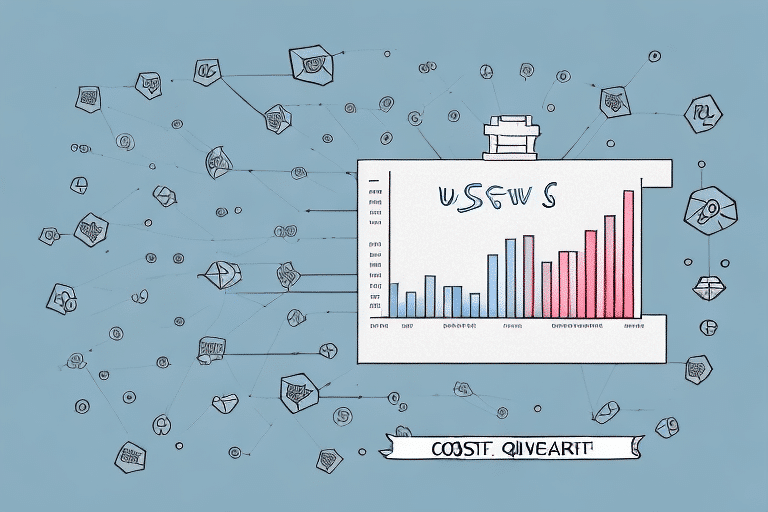Understanding Economic Order Quantity (EOQ)
As a business owner or manager, effectively managing inventory levels and costs is essential for maintaining profitability. One of the most effective inventory management techniques is Economic Order Quantity (EOQ). EOQ is a mathematical formula used to determine the optimal amount of inventory to order at one time. This article delves into the various aspects of EOQ, its benefits, and its relevance in today's dynamic business environment.
What is Economic Order Quantity (EOQ) and How Does It Work?
EOQ is a method used to identify the most efficient order quantity for a company's inventory. It strikes a balance between the cost of ordering inventory and the cost of holding it. This inventory management technique operates under the assumption that the demand for a product is constant and known in advance.
The formula for calculating EOQ is:
EOQ = √((2 × S × D) / H)
- S = Cost of placing an order
- D = Annual demand
- H = Holding cost per unit per year
By utilizing EOQ calculations, businesses can determine the optimal order quantity that minimizes total inventory costs, including ordering and holding expenses.
History and Evolution of Economic Order Quantity
EOQ was first introduced in 1915 by Ford W. Harris, a production engineer at Westinghouse Electric Company. Harris developed EOQ to optimize inventory control for a small manufacturing company, aiming to enhance efficiency and reduce costs.
Since its inception, EOQ has undergone several modifications and improvements. In the 1950s, as industrial demand for inventory control grew, EOQ became a staple in academic literature and industrial practice. Today, EOQ remains a fundamental tool in inventory management across manufacturing, retail, and wholesale industries.
Advancements in technology have further refined EOQ calculations, allowing for integration with enterprise resource planning (ERP) systems and real-time data analytics, enhancing its applicability and accuracy in modern business contexts.
Importance of EOQ in Inventory Management
Effective inventory management is crucial for running a successful business. EOQ plays a pivotal role by helping businesses maintain optimal inventory levels, thereby:
- Minimizing Costs: EOQ helps reduce ordering and holding costs, leading to overall cost efficiency.
- Preventing Stockouts and Overstocks: By balancing supply and demand, EOQ ensures that businesses avoid the pitfalls of both understocking and overstocking.
- Enhancing Cash Flow: Optimizing inventory levels frees up capital, allowing businesses to allocate resources to other critical areas.
According to a study by Investopedia, businesses using EOQ can reduce their inventory costs by up to 20%, highlighting its significant impact on profitability.
Calculating EOQ for Your Business
To calculate EOQ, you need the following information:
- Ordering Cost (S): The cost associated with placing an order.
- Annual Demand (D): The total quantity of a product expected to be sold or used in a year.
- Holding Cost (H): The cost to hold one unit of inventory for a year.
Using the EOQ formula:
EOQ = √((2 × S × D) / H)
For example, if a company has an ordering cost of $50, an annual demand of 10,000 units, and a holding cost of $2 per unit, the EOQ would be:
EOQ = √((2 × 50 × 10000) / 2) = √(500000) ≈ 707 units
There are several online calculators available that can simplify this computation, ensuring accurate and efficient EOQ determination.
It's important to note that EOQ should be recalculated periodically as factors like demand, ordering costs, and holding costs change over time. Incorporating dynamic models that adjust EOQ based on real-time data can further enhance inventory management efficiency.
Factors Affecting the EOQ Calculation
Several factors can influence the accuracy and effectiveness of the EOQ model:
- Demand Variability: Fluctuating demand can lead to inaccurate EOQ calculations, necessitating adjustments or the use of safety stock.
- Lead Time: The time between placing an order and receiving it affects inventory levels and reorder points.
- Order Costs: High ordering costs may justify larger, less frequent orders to minimize expenses.
- Holding Costs: Increased holding costs can incentivize smaller, more frequent orders to reduce inventory levels.
- Storage Capacity: Limited storage space may require adjusting EOQ to prevent overstocking.
Businesses must consider these factors when applying the EOQ model to ensure it aligns with their operational realities.
Research from the ScienceDirect database indicates that integrating EOQ with other inventory management practices can mitigate some of these challenges, leading to more robust and adaptable inventory systems.
EOQ Compared to Other Inventory Management Techniques
While EOQ is a widely used inventory management technique, it is not the only method available. Comparing EOQ with other techniques can help businesses choose the most suitable approach:
Just-In-Time (JIT)
JIT focuses on reducing inventory levels by receiving goods only as they are needed in the production process. Unlike EOQ, which emphasizes optimal order quantity, JIT aims to minimize inventory holding altogether.
Material Requirements Planning (MRP)
MRP is a system for calculating the materials and components needed to manufacture a product. It integrates data from production schedules with inventory control to manage manufacturing processes efficiently.
ABC Analysis
ABC Analysis categorizes inventory into three categories (A, B, and C) based on importance and value, allowing businesses to prioritize management efforts accordingly.
Each inventory management technique has its strengths and is suited to different business contexts. However, EOQ remains a foundational model due to its simplicity and effectiveness in cost optimization.
Advantages and Disadvantages of the EOQ Method
Advantages
- Cost Efficiency: EOQ helps minimize total inventory costs by balancing ordering and holding expenses.
- Simplicity: The EOQ formula is straightforward and easy to implement.
- Improved Inventory Control: EOQ aids in maintaining optimal inventory levels, reducing the risk of stockouts and overstocks.
- Enhanced Cash Flow: By optimizing inventory levels, EOQ frees up capital for other operational needs.
Disadvantages
- Assumption of Constant Demand: EOQ assumes steady demand, which may not reflect real-world fluctuations.
- Ignores Supplier Variability: Factors like supplier reliability and lead time variability are not accounted for in the basic EOQ model.
- Lack of Flexibility: EOQ may not be suitable for businesses with highly variable or seasonal demand.
Despite its limitations, EOQ remains a valuable tool when applied appropriately, often in conjunction with other inventory management strategies.
Real-Life Examples of Successful EOQ Implementation
Numerous businesses have successfully implemented EOQ to optimize their inventory levels and reduce costs:
- Automotive Manufacturing: A leading automotive manufacturer utilized EOQ to streamline its parts inventory, resulting in a 15% reduction in holding costs and improved production efficiency.
- Retail Sector: A major retail chain adopted EOQ for managing their seasonal inventory, which helped in minimizing stockouts during peak seasons and reducing excess inventory post-season.
- Healthcare Industry: Hospitals implemented EOQ to manage medical supplies, ensuring critical items were always in stock while minimizing storage costs.
These examples illustrate the versatility and effectiveness of EOQ across various industries, highlighting its role in enhancing operational efficiency and profitability.
Common Mistakes to Avoid When Implementing EOQ
While EOQ is a powerful inventory management tool, improper implementation can lead to suboptimal results. Common mistakes include:
- Ignoring Demand Variability: Failing to account for fluctuations in demand can result in inaccurate EOQ calculations, leading to stockouts or excess inventory.
- Overlooking Lead Times: Not considering supplier lead times can disrupt inventory replenishment, affecting the accuracy of reorder points.
- Neglecting Holding Costs: Underestimating holding costs can skew EOQ results, leading to inefficient inventory levels.
- Using Outdated Data: Relying on outdated or inaccurate data for EOQ calculations can undermine the model’s effectiveness.
To avoid these pitfalls, businesses should regularly review and update their EOQ parameters, incorporate flexibility into their inventory management practices, and integrate EOQ with other inventory strategies for enhanced accuracy and resilience.
Future Trends and Developments in Economic Order Quantity
The field of inventory management is continually evolving, and EOQ is no exception. Emerging trends include:
- Integration with Artificial Intelligence (AI): AI and machine learning are being leveraged to enhance EOQ calculations by analyzing vast datasets and identifying patterns that traditional models may overlook.
- Real-Time Inventory Management: Advances in technology enable real-time tracking of inventory levels, allowing for dynamic EOQ adjustments based on current data.
- Hybrid Models: Combining EOQ with other inventory management techniques, such as JIT and MRP, to create more comprehensive and adaptable inventory strategies.
- Sustainability Considerations: Incorporating environmental factors into EOQ calculations to promote sustainable inventory practices.
These advancements promise to enhance the accuracy, flexibility, and overall effectiveness of EOQ, making it even more relevant in the modern business landscape.
Conclusion: Is Economic Order Quantity Right for Your Business?
EOQ is a robust inventory management technique that helps businesses minimize inventory costs, optimize inventory levels, and enhance profitability. While it has its limitations, its simplicity and effectiveness make it accessible and valuable for businesses of all sizes. By understanding the benefits and potential challenges of EOQ, and by integrating it with other inventory management strategies, businesses can make informed decisions that drive operational efficiency and financial success.
For businesses looking to implement EOQ, it's crucial to continuously monitor and adjust the model based on real-time data and evolving market conditions. This proactive approach ensures that EOQ remains a relevant and powerful tool in achieving inventory optimization and sustaining competitive advantage.




















